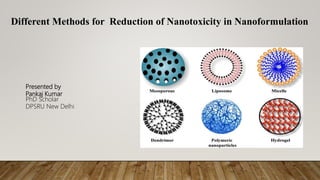Nanomaterials (pankaj kumar & satbir Singh)
- 1. Different Methods for Reduction of Nanotoxicity in Nanoformulation Presented by Pankaj Kumar PhD Scholar DPSRU New Delhi
- 2. Nanoformulation: The aims for nanoparticle entrapment of drugs are either enhanced delivery to, or uptake by, target cells and/or a reduction in the toxicity of the free drug to non-target organs. Nanoparticles may be needed for loading a sufficient amount of drug onto the particles. Nanoparticles as having dimensions below 0.1 ╬╝m or 100 nm Goals of nanoformulation - More specific drug targeting and delivery Reduction in toxicity Greater safety and biocompatibility Faster development of new safe medicines R. H. M├╝ller, M. Radtke, and S. A. Wissing, ŌĆ£Nanostructured lipid matrices for improved microencapsulation of drugs,ŌĆØ Int. J. Pharm., vol. 242, no. 1ŌĆō2, pp. 121ŌĆō128, 2002, doi: 10.1016/S0378-5173(02)00180-1.
- 3. Methods to reduce the nanotoxicity of nanoparticles ’ü▒ Functionalization Chemical functionalization is based on the covalent bond of functional groups onto carbon form of CNTs. It can be performed at the end caps of nanotubes or at their sidewalls which have many defects. ’ü▒ Toxicity can be also reduced by using organic NP ’üČ SNEDDS ’üČ SLN ’üČ NLC ’üČ ETHOSOMES ’üČ LIPOSOME ’üČ MICELLES ’üČ NIOSOEMS ’üČ TRANSFEROSOMES
- 4. ’ü▒ Reduce the size and length of nanoparticles Ex. length less than 5 ╬╝m CNT, gold NP (3-10nm) ’ü▒ Change shape of NP Ex. AU NP Triangular shape ’ü▒ Surface Modification e Ex. Chitosan , folic acid and PEG ’ü▒ Ion Release And Solubility ’ü▒ modified NP with suitable biomimetic polymers ’ü▒ Modify surface charge of NP M. A. Iqbal, S. Md, J. K. Sahni, S. Baboota, S. Dang, and J. Ali, ŌĆ£Nanostructured lipid carriers system: Recent advances in drug delivery,ŌĆØ J. Drug Target., vol. 20, no. 10, pp. 813ŌĆō830, 2012, doi: 10.3109/1061186X.2012.716845
- 5. Regulation of nanoparticles USFDA and the European Union (EU) have strong regulatory bodies and guideline legislation to control the potential risks of NPs. Loopholes ’ü▒ Stand Alone proposal: There are not common principles for the nanomaterials regulation that's why Nano drugs regulation are always cornerstone ’ü▒ Nanotechnologies require prudential regulators able to facilitate responsible development and to gain trust of organization ’ü▒ There is insufficient knowledge about the paths of technological developments and the characteristics and behavior of nanomaterials, including data on exposure and hazards ’ü▒ Requires broad ANALYTICAL FRAMEWORK: for the analysis of emerging regulation B. R. Dorbeck-Jung and N. Chowdhury, ŌĆ£Is the European Medical Products Authorisation Regulation Equipped to Cope with the Challenges of Nanomedicines?,ŌĆØ Law Policy, vol. 33, no. 2, pp. 276ŌĆō303, 2011, doi: 10.1111/j.1467-9930.2011.00339.x. .






